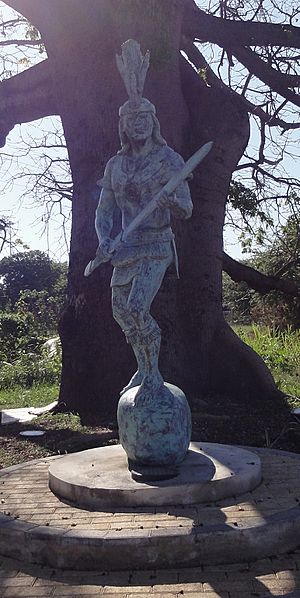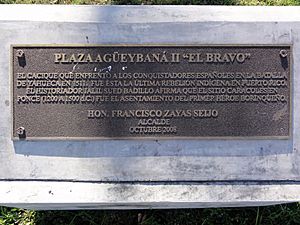Agüeybaná II facts for kids
Quick facts for kids
Agüeybaná II
|
|
|---|---|

Statue of Agüeybaná II, "El Bravo", in Ponce, Puerto Rico
|
|
| Nickname(s) | "El Bravo" (The Brave) |
| Born | c. 1470 "Borikén" |
| Died | 1511 (aged 40–41) Puerto Rico |
| Rank | Cacique |
| Commands held | Taínos of "Borikén" |
| Battles/wars | Taíno rebellion of 1511 |
| Relations | Brother of Agüeybaná |
Agüeybaná II (around 1470–1511), also known as Güeybaná or Agüeybaná El Bravo (meaning Agüeybaná The Brave), was a very important leader of the Taíno people in "Borikén". He was one of the two main caciques (chiefs) when the Spaniards first arrived in Puerto Rico in 1493. Agüeybaná II led the Taínos of Puerto Rico in a big fight against the Spanish, known as the "Taíno rebellion of 1511". This fight was against Juan Ponce de León and the Spanish Conquistadors.
Contents
Who Was Agüeybaná II?
Agüeybaná II, whose real name was Güeybaná, was the brother of another powerful chief named Agüeybaná. He lived with his tribe in a place called Guaynia (now Guayanilla), near a river. The name Agüeybaná means "The Great Sun." The "II" is added to his name to tell him apart from his older brother. All the other Taíno chiefs on the island had to follow Agüeybaná's orders, even though they ruled their own tribes.
First Contact with the Spanish
When Spanish explorer Juan Ponce de León arrived in Puerto Rico in 1508, Agüeybaná I, the older brother, welcomed him. Following an old Taíno custom called "guaytiao," Agüeybaná I and Juan Ponce de León became friends and even traded names. Agüeybaná I had been advised by his mother to be friendly with the Spaniards to avoid conflict. This kind welcome helped the Spaniards settle on the island easily. However, this peace between the Taíno and the Spanish did not last long.
The Taíno Rebellion of 1511
After Agüeybaná I died in 1510, his brother Güeybaná, now known as Agüeybaná II, became the most powerful chief on the island. Agüeybaná II was not sure if the Spaniards were truly gods, as some believed. He decided to test this idea. He and another chief named Urayoán (from Añasco) sent some of their people to trick a Spanish soldier named Diego Salcedo. They led him to a river and drowned him. They then watched his body for a long time to see if he would come back to life. When Salcedo did not revive, Agüeybaná II and the Taíno people realized that the Spaniards were not gods after all.
Agüeybaná II then held secret meetings and Areytos (war dances) with other chiefs. During these meetings, he planned a revolt against the Spaniards. A Spanish spy, Juan González, found out about Agüeybaná's plans. Despite the warning, Agüeybaná II attacked and killed Cristobal de Sotomayor and his men. Juan González was badly hurt but managed to escape and report the killings to Ponce de León. At the same time, Guarionex, the chief of Utuado, attacked the Spanish village of Sotomayor (today's Aguada) and killed many people.
After these attacks, Ponce de León led the Spaniards in several battles against the Taínos. These fights ended with the Battle of Yagüecas.
Death of Agüeybaná II
In 1511, a large group of Taínos, estimated to be between 11,000 and 15,000 warriors, gathered in the Yagüecas region to fight about 80 to 100 Spaniards. Before the main battle began, a Spanish soldier shot and killed a native warrior with a special gun called an arquebus. It is believed that this warrior was Agüeybaná II, because he was wearing a golden necklace, which only a chief would wear.
After the Battle
After Agüeybaná II's death, the Taíno warriors became disorganized and retreated. His followers decided to fight the Spaniards using guerrilla tactics, which means small groups would make surprise attacks. This type of rebellion continued for about eight years, until 1519. Another series of attacks happened in 1513 when Ponce de León left the island to explore Florida. During this time, the Spanish settlement of Caparra, which was the main government center, was attacked and burned by an alliance of Taínos and other native groups.
By 1520, the number of Taíno people on the island had greatly decreased. A government count in 1530 showed that only about 1,148 Taínos remained in Puerto Rico. The Taínos who survived continued to suffer from harsh treatment and a smallpox epidemic that hit the island in 1519.
Legacy of a Hero
Agüeybaná II is remembered and admired in Puerto Rico for his strong loyalty to his people. Many places and things in Puerto Rico are named after him:
- A high school in the city of Bayamón is named after him.
- There is a street in Caguas that honors him.
- An avenue in the Hato Rey area of San Juan is named Agüeybaná.
- Puerto Rico used to have an award similar to the Oscars, called the "Agüeybaná de Oro" (The Golden Agüeybaná), named in his honor.
- In Ponce, there is a park with a statue of Agüeybaná II, "El Bravo" (The Brave).
- A poet named Daniel de Rivera wrote a poem called "Agüeybaná El Bravo" dedicated to him. The poem talks about fighting for freedom and defending one's homeland.
See Also
 In Spanish: Agüeybaná II para niños
In Spanish: Agüeybaná II para niños
- List of Puerto Ricans
- Agüeybaná I
- List of Taínos
- Arasibo
- Hayuya
- Jumacao
- Orocobix
- Tibes Indigenous Ceremonial Center



